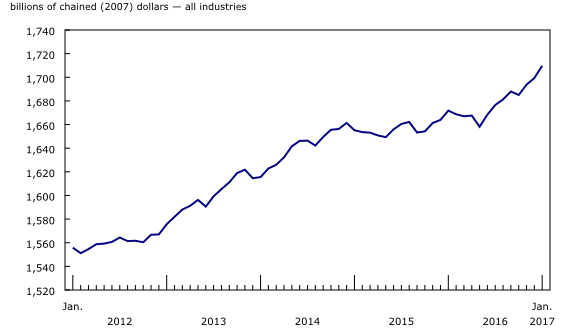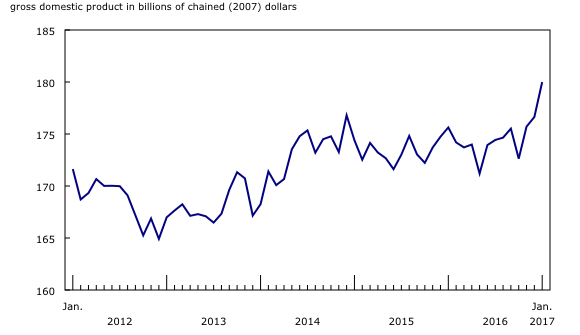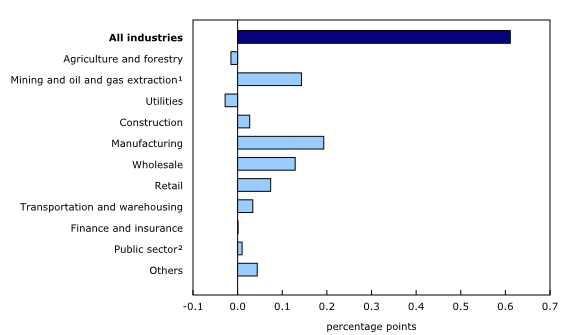Gross domestic product by industry, January 2017
Archived Content
Information identified as archived is provided for reference, research or recordkeeping purposes. It is not subject to the Government of Canada Web Standards and has not been altered or updated since it was archived. Please "contact us" to request a format other than those available.
Released: 2017-03-31
January 2017
0.6% 
(monthly change)
Gross domestic product grew 0.6% in January on the strength of widespread growth across both goods- and service-producing industries. With the exception of October, gross domestic product has risen every month since June 2016.
Goods-producing industries grew for the seventh time in eight months, increasing by 1.1% in January. Service-producing industries rose 0.4%, their highest monthly growth rate since June 2015.
Manufacturing continues to grow
The manufacturing sector was the largest contributor to the increase in gross domestic product, expanding 1.9% in January. With the exception of October, the manufacturing sector has grown every month since June 2016.
Durable manufacturing rose 2.0% in January, led by growth in fabricated metal, non-metallic mineral and wood product manufacturing. With the exception of miscellaneous manufacturing, all durable manufacturing subsectors rose.
Transportation equipment was up 0.6%, as growth in motor vehicle, motor vehicle body and trailer, aerospace product and parts and railroad rolling stock manufacturing was partly offset by declines in manufacturing of motor vehicle parts and other transportation equipment.
Non-durable manufacturing rose 1.8% in January, with growth in every subsector except paper manufacturing. Food manufacturing (+2.1%) was the major contributor to growth. There were also notable increases in beverage and tobacco product, plastic and rubber product and chemical manufacturing.
Mining, quarrying, and oil and gas extraction expands
Mining, quarrying, and oil and gas extraction expanded 1.9% in January after contracting 0.5% in December. Oil and gas extraction was up 2.0%, with increases in both conventional oil and gas extraction and non-conventional oil extraction. However, the increases in January did not offset the declines in December.
Mining and quarrying excluding oil and gas extraction was up for the fourth month in a row, rising 1.1% in January. Metal ore mining gained 4.4%, as iron ore mining, copper, nickel, lead and zinc ore mining and gold and silver ore mining expanded, in part from higher exports. Partially offsetting this growth were declines in non-metallic minerals mining (-3.2%) from lower potash extraction and coal mining (-2.8%). Support activities for mining and oil and gas extraction were up 2.7% from increased drilling activity, continuing a growth sequence since the third quarter of 2016 and following a slump that began in early 2015.
Wholesale trade posts largest gain since July 2013
Wholesale trade grew 2.4% in January, the largest monthly gain since July 2013. Growth in this sector was the largest contribution to the increase in service-producing industries. The majority of subsectors increased, led by a 14% gain at motor vehicle and parts wholesalers on higher exports and imports.
Farm products wholesalers' output increased on the strength of oilseed and grain dealers (such as canola dealers meeting increased demand from China). Wholesalers of personal and household goods, machinery, equipment and supplies, and food, beverage and tobacco also made large contributions to the sector's growth. The output of petroleum product wholesalers and miscellaneous wholesalers declined.
Retail sector continues to increase
Retail trade grew 1.5% in January, the sixth increase in seven months, with 10 of the 12 subsectors advancing. Motor vehicle and parts dealers rose 1.2%, primarily on the strength of more activity at new car dealers. The largest decline in terms of output was a 3.3% contraction at gasoline stations.
Transportation and warehousing grows
Transportation and warehousing grew 0.8% in January. Rail transportation (+5.0%) led the growth, as movement of intermodal freight, grain and fertilizer and automotive products increased. Pipeline transportation was up 1.9%, as movement of both natural gas and crude oil increased. Air and truck transportation posted gains, while the output of postal service and couriers and messengers and warehousing and storage declined.
Construction continues to expand
The construction sector expanded 0.4% in January. Residential construction (+0.5%) was up for a third consecutive month on increased alterations and improvements and a rise in apartment construction. Repair construction and engineering and other construction activities rose while non-residential construction declined as industrial, public and commercial construction contracted.
Real estate and rental and leasing activity edged up 0.1%.
The output of real estate agents and brokers declined 1.8% in January, as activity in the home resale market was down. Activity in this subsector has generally been declining since its peak in the second quarter of 2016.
Finance and insurance are unchanged
The finance and insurance sector was unchanged in January as growth in banking and other depository intermediaries was offset by a decline in financial investment services. Activity at insurance carriers was essentially unchanged.
Other industries
Accommodation and food services grew 0.9% in January as both accommodation services and food services and drinking places registered increases.
The utilities sector contracted 1.3% in January. The output of electric power generation, transmission and distribution and natural gas distribution declined as weather conditions were unseasonably mild across Canada, reducing demand for heating.
The public sector edged up 0.1% as a result of increased activity in public administration and educational services.
Agriculture, forestry, fishing and hunting was down for the third time in four months, declining 0.9% in January.

In celebration of the country's 150th birthday, Statistics Canada is presenting snapshots from our rich statistical history.
Today, we take a look back at the 1998 Ice Storm and its impact upon Real National Gross Domestic Product by Industry (GDP).
The January 1998 Ice Storm ranks as Canada's second most expensive natural disaster in terms of insured losses (the Fort McMurray wildfire in May 2016 is considered the most expensive based on estimated insured losses). Ice fell from the skies from January 4 to January 10, coating the St. Lawrence River Valley, southern New Brunswick and Nova Scotia with upwards of 110 millimeters of accumulated ice.
The ice storm had an effect on real GDP in January 1998, which fell 0.4% from December 1997. Electric power generation, transmission and distribution in the affected regions decreased as transmission lines buckled under the pressure of the ice and plunged parts of the area into darkness for up to three weeks.
Construction activity rose partly as a result of repair and rebuilding activities. As many residents in the affected areas were forced to leave their homes and seek shelter and food, accommodation and food services increased. However, with many residents also curtailing their activities such as shopping or attending an arts or sporting event, retail trade and the arts, entertainment and recreation sector declined. Public administration was affected as the Ottawa/Gatineau region was blanketed with ice, preventing employees from travelling to their place of work. Educational services decreased as students were told to stay home or schools were closed.
Note to readers
Monthly gross domestic product (GDP) by industry data at basic prices are chained volume estimates with 2007 as the reference year. This means that data for each industry and each aggregate are obtained from a chained volume index, multiplied by the industry's value added in 2007. Monthly data are benchmarked to annually chained Fisher volume indexes of GDP obtained from the constant-price supply and use tables (SUT) up to the latest SUT year (2013).
For the period starting with January 2014, data are derived by chaining a fixed-weight Laspeyres volume index to the prior period. The fixed weights are 2013 industry prices.
This approach makes the monthly GDP by industry data more comparable with expenditure-based GDP data, which are chained quarterly.
All data in this release are seasonally adjusted. For information on seasonal adjustment, see Seasonally adjusted data – Frequently asked questions.
For more information on GDP, see the video "What is Gross Domestic Product (GDP)?"
Revisions
With this release of monthly GDP by industry, revisions have been made back to January 2016.
Each month, newly available administrative and survey data from various industries in the economy are integrated and result in statistical revisions. Updated and revised administrative data (including taxation statistics), new information provided by respondents to industry surveys, and standard changes to seasonal adjustment calculations are incorporated with each release.
For more information about monthly national GDP by industry, see the System of Macroeconomic Accounts module on our website.
Real-time CANSIM tables
Real-time CANSIM table 379-8031 will be updated on April 10. For more information, consult the document Real-time CANSIM tables.
Next release
Data on GDP by industry for February will be released on April 28.
Contact information
For more information, contact us (toll-free 1-800-263-1136; 514-283-8300; STATCAN.infostats-infostats.STATCAN@canada.ca).
To enquire about the concepts, methods or data quality of this release, contact Allan Tomas (613-790-6570), Industry Accounts Division.
- Date modified:




